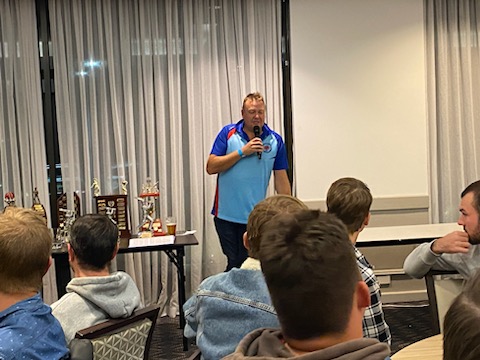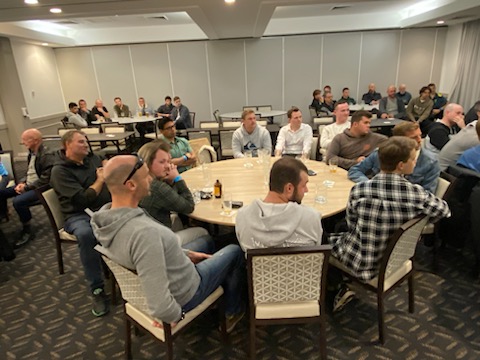Fast / Medium Paced Bowling
- Bowling should be driven into the players over the season:
- Correct measuring of run-up
- Starting run up at a balanced and leisurely pace accelerating to top speed at point of delivery
- The delivery action must have a high front arm
- The bowler must keep their heads still with eyes focussed on the spot where the ball should land
- Once ball leaves bowlers hand, they must follow straight through about 2 paces then veering to the edge of the pitch
- Once bowlers have become adept to this stage, the following can then be shown, hoping they will pick up how to bowl a good line with variation:
- Bowler must have a stock delivery, just short of a good length, between on or 1 foot outside the off stump
- Bowlers to be shown how to grip ball and bowl outswingers, leg cutters, off cutters, slower balls, Yorkers and bouncers.
- Where to place feet in delivery stride eg, wide off popping crease slanting the ball into the batsmen
- How and when to bowl a bumper
- How to work in with your keeper
- Any player can run up and swing their arm over. To become a good bowler you have to think about the batsmen you hope to dismiss eg. If the batsman is trying to get on the front foot to drive or defend, force him on the back foot with balls just short of his reach. Give him the bouncer now and again at the middle stump. The bowler who can find a flaw in a batsmen, then work on that weakness until he gets his wicket is the player who could develop into a top bowler. All great pace bowlers have a smooth relaxed run up, attacking the off stump, varying their stock ball with leg or off cutters, only rarely did they waste deliveries bowling wide of the wicket, they made batsmen play at the ball.
- The following tips might be of some use to bowlers hoping to improve their bowling:
- If a batsmen has a big back lift, give him a couple of short deliveries, then rip a couple into the block hole trying to yorker him.
- When a batsmen is scared of short balls, give it to him and have a fieldsman in close on the leg side, but don’t overdo it, make sure it’s a surprise. Bowl about three stock balls in a row, then give him a bouncer into his ribs. Make sure your keeper knows when you are to bowl such a delivery.
- If such a batsmen does decide to attack, revert in close fieldsmen to their normal positions.
- If you strike a batsmen who is a big hitter, try him with a fast one in the block hole, then a similar delivery, but much slower, having both a deep cover and deep mid on. You could also have a deep mid wicket. Don’t overdo the one type of ball to such a batsmen, try all the variations you can bowl.
- Always concentrate on bowling your stock ball around off stump to bowl to the field your captain has placed.
- Bowling to a left hand batsmen, try an over around the wicket, bowling wide of the popping crease to slant the ball from outside the off stump into his off and middle stumps. When bowling a bouncer again slant the short pitched ball in towards his neck region, never bowl a bouncer too far down the leg side, if possible you have to make him play at the ball. Have a silly leg when attacking.
- If he’s still batting, try an over, over the wicket attacking his off stump slanting the ball across his body. Again use variety.
- If you bowl a no ball, re-measure your run up, making sure your front foot is about 6” to 1 foot behind the line. There should be no excuse for bowling repeated no balls by overstepping.
- Taking wickets is your job, but also try to keep the run scoring as low as you can. No more than 20 runs can be allowed from your 6 over spell. Even then at that run rate, their team will score around 200 runs. But if you bowl to a good line around the off stump, you have done your job, it’s then up to your fieldsmen to support you.
Spin Bowling
Spin bowlers also have to have a stock ball, both off and leg spin should again be around the off stump, with leg spinners varying their deliveries on the leg and middle stumps, then they must learn how to bowl and control deliveries to confuse the batsmen.
- Flat deliveries straight, flat delivery with spin, flighted deliveries with spin, faster deliveries
- The flighted deliveries are best utilised when bowling into a breeze, especially when a north-easter is blowing.
- Again as fast bowlers you must try to work out each batsmen and ascertain any weaknesses
- You must establish a combination with your keeper. When bowling your faster ball, have a signal planned to let him know
- Once you have delivered the ball, be alert for any catches that may come your way.
General Tips
When bowling in matches and in the nets, no bowler should have a longer run up than 13 paces. In the nets use a relaxed and slower approach than normal, just concentrating on a good line at ¾ pace, practicing leg cutters on the off stump, yorkers etc.
Always warm up before practice and matches using stretching exercises on legs, arms and back. All bowlers should have a short sleeve jumper and worn after bowling spells to protect the player’s back, even on hot days.
If you think you have any problems with your bowling or any ideas, don’t be backwards in informing the coach.






















































Comments are closed, but trackbacks and pingbacks are open.